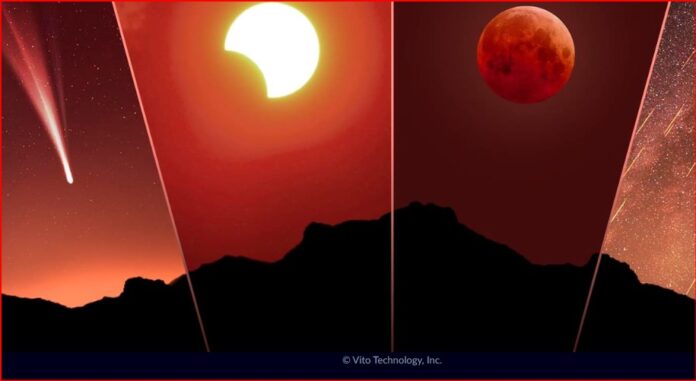The month of May 2025 is shaping up to be a dazzling spectacle for skywatchers. From a micromoon known as the “Flower Moon” to a rare Saturn equinox and vibrant meteor showers, there are plenty of reasons to step outside and look up. Whether you’re a seasoned astronomer or a curious stargazer, this month’s sky offers a packed calendar of can’t-miss celestial events.
Key Skywatching Events This May
Here’s your guide to the top astronomical happenings in May, including where and when to catch them.
🌒 May 3 — The Moon, Mars, and the Beehive Cluster
- Just after sunset on May 3, look westward to witness a stunning celestial triangle: the crescent moon, the planet Mars, and the Beehive Cluster (Messier 44).
- The Beehive Cluster, located about 577 light-years from Earth in the constellation Cancer, contains over a thousand stars.
- While some stars are visible to the naked eye, binoculars or a telescope reveal the full splendor of this open star cluster.
- One “bee” in the swarm will appear reddish—that’s Mars shining among the stars.
☄️ May 5–6 — Eta Aquariid Meteor Shower Peak
- The Eta Aquariids, active from April 20 to May 21, peak during the night of May 5 and into the early morning hours of May 6.
- Linked to Halley’s Comet, this shower is known for fast, streaking meteors that can glow for several seconds or even minutes.
- Peak rates:
- Southern Hemisphere: Up to 50 meteors per hour.
- Northern Hemisphere: Typically 10–20 meteors per hour.
- The moon will set by 3 a.m., creating dark skies perfect for meteor viewing.
🪐 May 6 — Saturn’s Rare Equinox
- Saturn will experience an equinox on May 6—a phenomenon that only happens once every 15 Earth years.
- During this event, sunlight strikes Saturn’s equator directly, causing its rings to appear edge-on and nearly vanish from view.
- This offers a rare opportunity to observe Saturn’s rings in a strikingly thin profile.
✨ May 11 — Messier 5 Globular Cluster at Its Peak
- The globular cluster Messier 5 (M5) will be perfectly positioned for viewing on May 11.
- Located around 25,000 light-years away, M5 is a dazzling ball of ancient stars that offers a glimpse into the early Milky Way.
- Through a telescope, you can view the cluster’s bright core and outer halo of faint stars.
🌕 May 12 — Full “Flower Moon”
- May’s full moon, known as the “Flower Moon,” will reach its peak on May 12.
- According to the Farmer’s Almanac, the name reflects the blooming of spring flowers across North America.
- This year’s Flower Moon is a micromoon, occurring when the moon is at apogee—its farthest point from Earth—making it appear slightly smaller and dimmer than usual.
- Despite its size, the moon will look impressively large when seen near the horizon, due to the Moon Illusion.
- This will also be the final micromoon of 2025.
🌙 May 22 — Moon and Saturn’s Close Encounter
- On the night of May 22, look toward the sky to spot Saturn just 2°28′ from the waning crescent moon.
- That’s roughly the width of 2.5 pinky fingers held at arm’s length.
- Through binoculars, you can see both celestial bodies, though a telescope’s narrower field will only show one at a time.
- Saturn’s rings will still appear thin due to the recent equinox.
🌌 May 26 — Best Stargazing Conditions of the Month
- A new moon on May 26 means no lunar interference, providing optimal conditions for stargazing.
- Faint celestial objects like nebulae, galaxies, and star clusters will be easier to observe.
- Consider connecting with a local astronomy club or borrowing binoculars from a library to enhance your stargazing experience.
🔭 May 28 — Messier 4 Globular Cluster Visibility
- If you missed M5 earlier in the month, catch the “well-placed” globular cluster Messier 4 (M4) on May 28.
- At just 5,500 light-years away, M4 is the closest globular cluster to Earth.
- With over 100,000 stars, including roughly 40,000 white dwarfs, M4 reveals the dense remnants of ancient stars.
- A powerful telescope is needed to spot its faint, dim stars.
🌟 May 31 — Venus at Greatest Western Elongation
- Venus, often called the “morning star,” will shine brilliantly before dawn on May 31 as it reaches its greatest western elongation.
- At this point, Venus appears at its farthest distance west of the sun, making it one of the most easily spotted objects in the early morning sky.
Tools for Stargazing
To plan your best skywatching nights, consider using the Sky Tonight app. The app features an astronomical calendar and an interactive sky map that helps you find celestial objects in real time.



